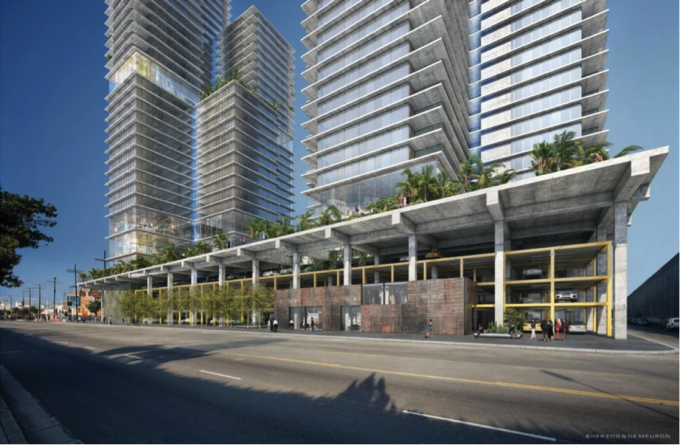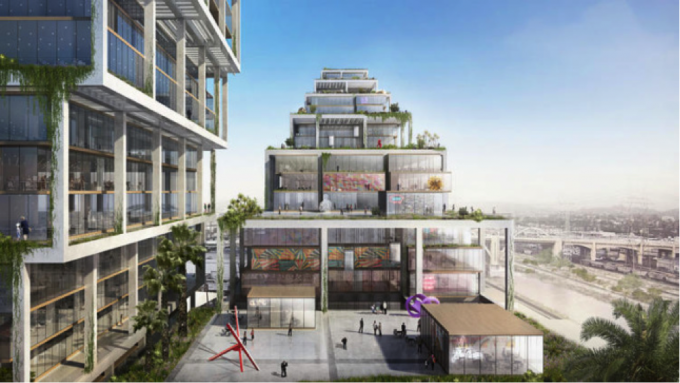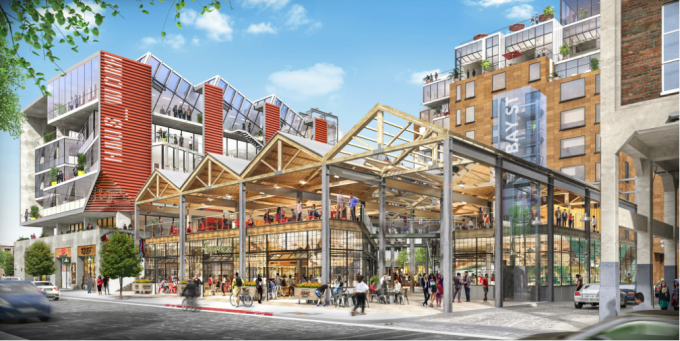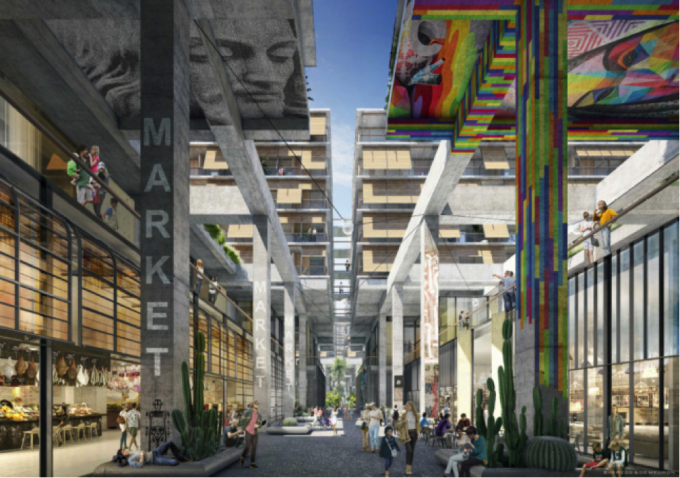March 09, 2017
Bombastic, brand-name architecture is transforming the L.A. Arts District
ANTONIO PACHECO
The Architect’s Newspaper

Herzog & de Meuron have revealed more details and a new rendering for their 6AM project in Los Angeles. (Courtesy Los Angeles Department of City Planning)
Los Angeles’s Arts District neighborhood is seeing a rapid influx of large-scale, developer-driven mixed-use projects, which are poised to upend the enclave’s status as an affordable, artists’ neighborhood.
Within the last six months, several large-scale proposals by international and local firms have shaken up the Arts District’s development trajectory by injecting an infusion of branded architecture. Irvine, California–based developer SunCal and Swiss architects Herzog & de Meuron have partnered on the 6AM project, a $2 billion development located at the intersection of 6th and Alameda Streets. Initial plans call for roughly 2.8 million square feet of mixed-use development to the southern edge of the district, including 1,305 apartments and 431 condominiums.
The project’s retail areas will be contained within a multi-story ground-level podium that will act as a literal platform for the housing units above, articulated as long bars of apartments. The platform is designed as a collection of raw concrete structural components—square columns, rectangular beams, and a thin slab—raised high enough off the ground to create large expanses of covered outdoor space along the street and what amounts to a cavernous, open-air mall within. The interior of the retail complex will be carved into various blocks, with alternating exposures of the housing above looking down into the interior shopping streets. The complex is capped along Alameda Street by a collection of housing towers. Mia Lehrer + Associates will act as landscape architect for the project and AC Martin will serve as executive architect. 6AM is expected to be built in three phases starting around 2018.

BIG has unveiled a 250-unit mixed-use complex for L.A.’s Arts District (Courtesy Bjarke Ingels Group)
On the district’s opposite end, Bjarke Ingels Group (BIG) and real estate firm V.E. Equities have teamed up for 670 Mesquit, a project aligned directly with the edge of the L.A. River. 670 Mesquit is articulated as a large composition of gridded concrete frames infilled with various types of programming. The project will contain 800,000 square feet of office space, 250 residential units, and two specialty hotels, as well as a collection of open air, publicly oriented facilities designed to connect the neighborhood with the river. These amenities will span across a depressed rail yard that currently separates the district from the river along the longest edge of the site.
BIG’s buildings are organized as a series of generic structural bays stacked in a stepped configuration, with each bay of the superstructure measuring 45 feet on each side. These bays can be customized by the final tenants, an arrangement that allows the occupants to add mezzanines within each volume or fully subdivide existing spaces with new floors. In a reference to the repetitive armature the firm has designed, Bjarke Ingels, founder of BIG, is quoted in the Los Angeles Times as saying, “we want to create this framework where the bones of the building are what unite it.”

Exterior view of new 2110 Bay development. (Courtesy Studio One Eleven)
2110 Bay, a 1.8-acre development on the southern edge of the district by Los Angeles–based Studio One Eleven will bring 50,000 square feet of commercial space, a 100,000-square-foot office building, and a 110-unit, roughly 140-foot tall “live-work tower” to the area. The architects will repurpose an existing industrial shed in order to create an airy shopping and dining plaza. The new complex will be outfitted with steel and wood elements in a nod to the neighborhood’s industrial past and have direct visual connections to the surrounding housing and office programs. Alan Pullman, senior principal at Studio One Eleven, described the partial adaptive reuse approach: “[We wanted to] design a project that felt like it was very connected to the existing character of the Arts District.” Dubbed the “Retail Shed,” the repurposed structure is surrounded on three sides by new construction, with the mix of buildings articulated in a variety of finishes, including corrugated metal siding, raw concrete, and brick.
The complex is crisscrossed by covered outdoor walkways, like the other projects described above, in an effort to weave public open space between private functions. Pullman explained that the abundance of these types of spaces—perhaps due to impact the quality of life and overall feel of the Arts District more than the new works of architecture themselves—was rooted in the district’s zoning code. “We always try to create a more fine grained ground plane when we can,” he said. “If there is an urban design regulation that gives you an incentive to create a paseo on the ground plane—like the hybrid industrial zoning does—you push for it.”

(Courtesy Herzog & De Meuron)
The area is being remade in the image of contemporary creative capitalism as an urban-suburb, a place where educated and wealthy inhabitants move to cement their status as professional workers. The situation is common among American cities of today: An existing industrial neighborhood, aggressively colonized by monied interests and repopulated by creative class workers, shifts from a predominantly manufacturing-based or underground arts existence toward one based on leisure, consumption, and domesticity. The arrival of bombastic, brand-name architecture is integral to this transformation—think of SHoP Architects’ 3.3-million-square-foot plan for the Domino Sugar Factory on the Williamsburg waterfront in Brooklyn or Foster + Partners’ 2.4-million-square-foot Oceanwide Center project in San Francisco’s Transbay district—and the Arts District is no different.


